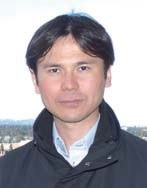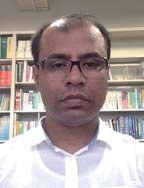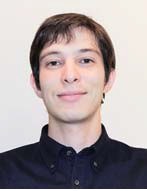拠点研究員のプロフィール
|
|
David SulzerMolecular Science Division ResearcherGraduate School of Informatio Science,Nagoya University Graduatedinphysical-chemistry at the University of Strasbourg (France), and received a doctorate in theoretical chemistry in the same university.Engaged in research to enhance solar panel using theoretical methods at the Graduate School of Information, Nagoya University |
Motivation for applying for the positionTo decipher the properties of matter and propose new technologies, I would like to develop and apply quantum chemistry methods. I think that using them to help finding alternative and more ecological ways to produce energy is an important and motivating purpose. Mission/RoleTo develop a new approach to model and understand the electron transfer process in Dye Sensitizers Solar Cells (DSSC) at the edge between molecular and solid state simulations. |
|---|---|---|
AmbitionProvide a better understanding of the process occurringin DSSC and proposene new molecules that could enhance the overall efficiency and cost of currently available solarpanels. |
||
 |
西原 泰孝にしはら やすたか 分子科学拠点研究員東京大学分子細胞生物学研究所
京都大学大学院で理論化学を専攻、博士(理学)を取得。 東京大学分子細胞生物学研究所でタンパク質の構造と機能の関係を研究。 |
応募の動機タンパク質の構造変化の研究対象は、より広い空間スケール・より長い時間スケールにシフトしています。そのため大規模並列計算が必要で、その技術の獲得と応用を行いたいと考えました。
ミッション/役割カスケード型の分子シミュレーション法のさらなる改良を行うことで、タンパク質・膜系の構造変化を効率良く引き起こす手法の開発に取り組みます。 |
|---|---|---|
抱負タンパク質の動きを分子レベルで解明することで、タンパク質の機能発現のメカニズムの解明や機能制御の手法の確立に貢献したいと思います。 |
||
 |
Moshiour RahamanCondensed MatterPhysics Division ResearcherDepartment of Materials Engineering, The University of Tokyo Majoredin Materiais Science at KTH Royal Institute of Technology, Stockholm and received his Ph.D. |
Motivation for applying for the positionConducting research at the nanoscale level in materials science. Mission/RoleTo develop the non-equilibrium Green’s function (NEFG) techniques combined with real-space density functional theory (RSDFT) for investigat ing the electron transport of nano-materials. |
|---|---|---|
AmbitionUnderstanding the physical properties of materials using the state-of-the-art first-principles method. |
||


